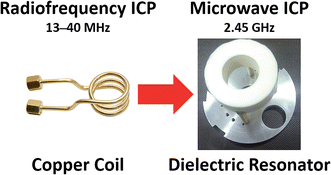New inductively coupled plasma for atomic spectrometry: the microwave-sustained, inductively coupled, atmospheric-pressure plasma (MICAP)†
Abstract
A novel inductively coupled plasma (ICP), termed the microwave-sustained, inductively coupled, atmospheric-pressure plasma (MICAP), has been developed that operates at microwave frequency (2.45 GHz). To sustain the new plasma, a dielectric resonator ring (fabricated from an advanced technical ceramic) is coupled with a 2.45 GHz microwave field generated from a microwave-oven magnetron. The microwave field induces polarization currents (small shifts in the equilibrium positions of bound electrons) in the resonator that generate an orthogonal magnetic field, analogous to that produced by electrical current within a traditional ICP load coil. This magnetic field is capable of sustaining an annular plasma in either air or nitrogen that can readily accept solution samples in the form of a wet aerosol produced from a conventional nebulizer and a spray chamber. An initial analytical evaluation of the MICAP with radially viewed optical emission spectrometry (OES) revealed that limits of detection ranged from 0.03–70 ppb with relative standard deviations from 0.7–2.0%. In addition, the new plasma exhibited good tolerance to solvent loading, and was found to be capable of accepting a wide variety of organic solvents directly and salt solutions up to 3% w/w concentration. Combined, the results suggest that the MICAP could be a competitive, simpler alternative to traditional, radiofrequency argon ICP-OES.


 Please wait while we load your content...
Please wait while we load your content...